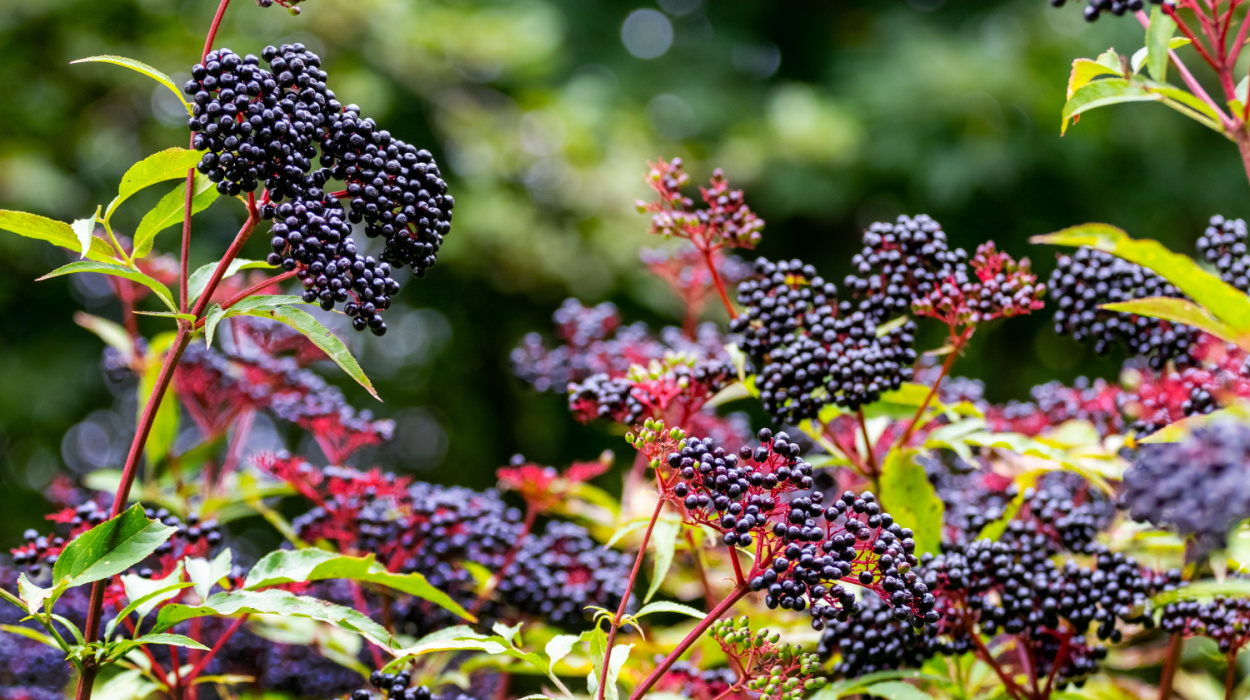Elderberry is frequently taken as a dietary supplement to combat the common cold and flu symptoms. Yet, to get to this stage, the elderberry plant undergoes various processing steps.
So, what does this mean? Is elderberry poisonous?
Common elderberry plants are known as Sambucus canadensis, and fresh berries in their raw form may not be safe to consume right from the bush. So, before gathering berries from this deciduous shrub, you’ll want to keep reading.
Is Elderberry Poisonous?
This depends on how and what part of the plant you consume. It’s not recommended to eat the bark, twigs, or roots of the elderberry plant due to its toxic contents. However, ripe elderberries can be enjoyed. For the most part, it’s suggested to cook them before eating. This destroys the toxic cyanogenic glycosides in the berries and seeds.
Is Elderberry Poisonous?

This usually depends on what part of the plant you’re eating. As with anything in nature, you want to double-check that it’s safe to eat. The elderberry bush is no exception.
While the benefits of berries are discussed just as much as the benefits of olives, the elderberry has a few precautions to be aware of.
Elderberry plants are frequently used to create supplements, elderberry juice, elderberry jelly, and even elderberry wine. Known for its range of health benefits, most are quick to assume that elderberry is classified alongside other edible plants. But even ripe berries and other parts of the plant may cause nausea, vomiting, and more, especially when consumed in high amounts.
This is largely because elderberries contain cyanogenic glycosides. While you may think you’re eating one of the healthiest fruits, in high doses, elderberry can be toxic because of the cyanide-inducing glycoside.
The level of toxicity may depend on the type of elderberry being consumed. So, is red elderberry poisonous? Is black elderberry poisonous? Let’s take a closer look.
Black Elderberry
Black elderberry, also called Sambucus nigra or the European or American elderberry, is the most common type of elderberry plant. These elderberry plants contain cyanogenic glycosides, which are toxic to all animals. However, the good news is that it’s very low[1] amounts.
It’s worth noting that ingesting large amounts of elderberry products[1] can lead to uncomfortable symptoms. These include nausea, vomiting, weakness, and dizziness. Generally, these compounds are toxic to protect the plant from other species.
Research shows that cooked elderberries[2] tend to have a lower cyanogenic glycoside content. Unfortunately, cooking elderberries also decreases the antioxidant properties that these plants are known for.
Red Elderberry
Red elderberries are also called Sambucus racemosa. These plants are largely found in California and Arizona. So, are they poisonous?
Red elderberry[3] seeds are considered slightly poisonous. But interestingly, anecdotally, when the seeds are removed, these berries can be enjoyed raw or cooked. However, cooking them to remove the toxicity completely is highly recommended.
Green Elderberry
Green berries mean the berries are unripe. Unripe berries are especially high in toxic cyanogenic glycosides.[4] This means green elderberries are best avoided.
Instead, enjoy fully ripe berries while considering the precautions outlined in this article, such as consuming cooked elderberry products.
Blue Elderberry
Blue elderberry[5] is also called Sambucus mexicana. Like other varieties of the elderberry plant, avoiding uncooked berries, leaves, twigs, or seeds is recommended.
If you’re wondering how to start eating healthy, picking elderberries straight from the bush might not be the best idea. Instead, it’s best to consume elderberries after cooking or processing. You could also opt for other healthy late-night snacks or supplements like green powders.
How Much Elderberry Is Poisonous?
Research indicates that ingestion of 0.5 – 3.5 mg per kg of body weight of cyanide leads to acute toxicity.[1] This can result in reduced consciousness, low blood pressure, coma, or even death. The amount of elderberry that is toxic is variable depending on the individual and their body weight.
Symptoms Of Elderberry Poisoning

Signs of cyanide poisoning[1] that occur when consuming too many elderberries include:
- Anxiety.
- Headaches.
- Nausea.
- Vomiting.
- Abdominal cramps.
- Diarrhea.
- Dizziness.
- Confusion.
- Weakness.
- Low blood pressure.
- Loss of consciousness.
- Coma.
If you notice any of the signs above after consuming raw elderberry, it’s important to go to the emergency room, as symptoms could worsen. As previously mentioned, the worst outcome could be death due to cyanide poisoning.
Preventing Elderberry Poisoning
While the American elderberry has been used for various herbal remedies, like immune support, correct preparation is key. The FDA does not monitor the safety of elderberry preparations, so reading the label is important. Raw, whole, unprocessed elderberries are not generally recommended for consumption. Instead, cooking them or consuming processed variations is best.
It’s further recommended to completely avoid the roots, leaves, bark, and stems of the elderberry plant.
After cooking elderberries, you can then go on to create delicious and beneficial foods like:
- Syrups.
- Jellies.
- Juice.
- Teas.
- Capsules.
- Tinctures.
- Gummies.
Many of these can also be found in the supplement aisle of your local pharmacy or grocery store. It’s often recommended to buy processed or cooked elderberries. This ensures none of the toxic elements are present.
Conclusion
Overall, it’s probably not wise to forage from elderberry bushes. If you intend to eat berries found in the wild, ensure you know the factors for proper plant identification. High concentrations of fresh elderberry can lead to unwanted digestive symptoms and even more serious symptoms, like coma or death.
Additionally, certain individuals, such as those pregnant, breastfeeding, or on medication, should not consume elderberry. If you have a health condition, discussing your options with your doctor before eating any elderberry or consuming its products may be best.
Elderberry is well-known for its health benefits, particularly its high antioxidant properties.[6] Thus, along with some of the best fruit and vegetable supplements, elderberries can be a great addition to your wellness regime.
Frequently Asked Questions
Elderberries, especially in high amounts, can be toxic to humans. It’s best to cook elderberries and remove their seeds before eating them. Additionally, elderberry in supplement form is safer as the toxic components have likely been removed in processing.
Unfortunately, consuming elderberries raw may lead to digestive symptoms like nausea, diarrhea, and vomiting. Thus, it’s always best to cook the berries before eating.
No, when cooked, elderberries are not poisonous. This is why they can be enjoyed in jellies, juice, preservatives, pies, and more.
Yes, boiling elderberries will make them less potent in vitamin C.[7] This is why many will recommend consuming them raw, but there is a risk of doing so.
Cooking the berries destroys the toxic elements in them. This makes them safer to eat.
The seeds, stems, roots, and leaves are considered toxic or poisonous. Once the seeds are removed, the berries are generally edible. However, it’s often recommended to cook the berries before consumption.
Those who are pregnant or breastfeeding should not consume elderberries. It may also not be appropriate for those on certain medications. If you take medications regularly or have a health condition, talk to your doctor before consuming elderberry.
No solid evidence indicates elderberry is bad for the kidneys. However, it’s always important to follow the instructions on the label of any supplement you take, including elderberry.
 Evidence Based
Evidence Based
